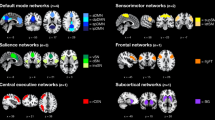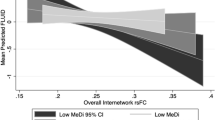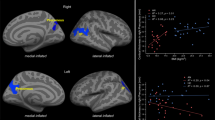Abstract
Background
Obesity is associated with brain intrinsic functional reorganization. However, little is known about the BMI-related interhemispheric functional connectivity (IHFC) alterations, and their link with executive function in young healthy adults.
Methods
We examined voxel-mirrored homotopic connectivity (VMHC) patterns in 417 young adults from the Human Connectome Project. Brain regions with significant association between BMI and VMHC were identified using multiple linear regression. Results from these analyses were then used to determine regions for seed-voxel FC analysis, and multiple linear regression was used to explore the brain regions showing significant association between BMI and FC. The correlations between BMI-related executive function measurements and VMHC, as well as seed-voxel FC, were further examined.
Results
BMI was negatively associated with scores of Dimensional Change Card Sort Test (DCST) assessing cognitive flexibility (r = −0.14, p = 0.006) and with VMHC of bilateral inferior parietal lobule, insula and dorsal caudate. The dorsal caudate emerged as a nexus for BMI-related findings: greater BMI was associated with greater FC between caudate and hippocampus and lower FC between caudate and several prefrontal nodes (right inferior frontal gyrus, anterior cingulate cortex, and middle frontal gyrus). The FC between right caudate and left hippocampus was negatively associated with scores of DCST (r = −0.15, p = 0.0018).
Conclusions
Higher BMI is associated with poorer cognitive flexibility performance and IHFC in an extensive set of brain regions implicated in cognitive control. Larger BMI was associated with higher caudate-medial temporal lobe FC and lower caudate-dorsolateral prefrontal cortex FC. These findings may have relevance for executive function associated with weight gain among otherwise healthy young adults.
This is a preview of subscription content, access via your institution
Access options
Subscribe to this journal
Receive 12 print issues and online access
$259.00 per year
only $21.58 per issue
Buy this article
- Purchase on Springer Link
- Instant access to full article PDF
Prices may be subject to local taxes which are calculated during checkout



Similar content being viewed by others
References
Gupta A, Osadchiy V, Mayer EA. Brain–gut–microbiome interactions in obesity and food addiction. Nat Rev Gastroenterol Hepatol. 2020;17:655–72.
Cohen JI, Yates KF, Duong M, Convit A. Obesity, orbitofrontal structure and function are associated with food choice: a cross-sectional study. BMJ Open. 2011;1:e000175-e.
Yang Y, Shields GS, Guo C, Liu Y. Executive function performance in obesity and overweight individuals: a meta-analysis and review. Neurosci Biobehav Rev. 2018;84:225–44.
Galioto R, Bond D, Gunstad J, Pera V, Rathier L, Tremont G. Executive functions predict weight loss in a medically supervised weight loss programme. Obes Sci Pract. 2016;2:334–40.
Kullmann S, Heni M, Veit R, Ketterer C, Schick F, Häring H-U, et al. The obese brain: association of body mass index and insulin sensitivity with resting state network functional connectivity. Hum Brain Mapp. 2012;33:1052–61.
Garcia-Garcia I, Angeles Jurado M, Garolera M, Segura B, Sala-Llonch R, Marques-Iturria I, et al. Alterations of the salience network in obesity: a resting-state fMRI study. Hum Brain Mapp. 2013;34:2786–97.
Doucet GE, Rasgon N, McEwen BS, Micali N, Frangou S. Elevated body mass index is associated with increased integration and reduced cohesion of sensory-driven and internally guided resting-state functional brain networks. Cerebr Cortex. 2017;28:988–97.
Beyer F, Masouleh SK, Huntenburg JM, Lampe L, Luck T, Riedel-Heller SG, et al. Higher body mass index is associated with reduced posterior default mode connectivity in older adults. Hum Brain Mapp. 2017;38:3502–15.
Sadler JR, Shearrer GE, Burger KS. Body mass variability is represented by distinct functional connectivity patterns. NeuroImage. 2018;181:55–63.
García-García I, Jurado MÁ, Garolera M, Marqués-Iturria I, Horstmann A, Segura B, et al. Functional network centrality in obesity: a resting-state and task fMRI study. Psychiatry Res: Neuroimaging. 2015;233:331–8.
Moreno-Lopez L, Contreras-Rodriguez O, Soriano-Mas C, Stamatakis EA, Verdejo-Garcia A. Disrupted functional connectivity in adolescent obesity. Neuroimage-Clin. 2016;12:262–8.
Geha P, Cecchi G, Constable RT, Abdallah C, Small DM. Reorganization of brain connectivity in obesity. Human Brain Mapp. 2017;38:1403–20.
Baek K, Morris LS, Kundu P, Voon V. Disrupted resting-state brain network properties in obesity: decreased global and putaminal cortico-striatal network efficiency. Psychol Med. 2016;47:585–96.
Lips MA, Wijngaarden MA, van der Grond J, van Buchem MA, de Groot GH, Rombouts SA, et al. Resting-state functional connectivity of brain regions involved in cognitive control, motivation, and reward is enhanced in obese females. Am J Clin Nutr. 2014;100:524–31.
Contreras-Rodríguez O, Martín-Pérez C, Vilar-López R, Verdejo-Garcia A. Ventral and dorsal striatum networks in obesity: link to food craving and weight gain. Biol Psychiatry. 2017;81:789–96.
Tomiyama H, Nakao T, Murayama K, Nemoto K, Ikari K, Yamada S, et al. Dysfunction between dorsal caudate and salience network associated with impaired cognitive flexibility in obsessive-compulsive disorder: a resting-state fMRI study. NeuroImage: Clin. 2019;24:102004.
Saindane AM, Drane DL, Singh A, Wu J, Qiu D. Neuroimaging correlates of cognitive changes after bariatric surgery. Surg Obesity Relat Dis. 2020;16:119–27.
Zuo X-N, Kelly C, Di Martino A, Mennes M, Margulies DS, Bangaru S, et al. Growing together and growing apart: regional and sex differences in the lifespan developmental trajectories of functional homotopy. J Neurosci. 2010;30:15034–43.
Zhao J, Manza P, Wiers C, Song H, Zhuang P, Gu J, et al. Age-related decreases in interhemispheric resting-state functional connectivity and their relationship with executive function. Front Aging Neurosci. 2020;12:20. Article
Li KC, Luo X, Zeng QZ, Xu XJ, Huang PY, Shen ZJ, et al. Distinct patterns of interhemispheric connectivity in patients with early- and late-onset Alzheimer’s disease. Front Aging Neurosci. 2018;10:261.
Wang Z, Wang J, Zhang H, Mchugh R, Sun X, Li K, et al. Interhemispheric functional and structural disconnection in Alzheimer’s disease: a combined resting-state fMRI and DTI study. Plos One. 2015;10:e0126310.
Hoptman MJ, Zuo XN, D’Angelo D, Mauro CJ, Butler PD, Milham MP, et al. Decreased interhemispheric coordination in schizophrenia: a resting state fMRI study. Schizoph Res. 2012;141:1–7.
Canna A, Prinster A, Monteleone AM, Cantone E, Monteleone P, Volpe U, et al. Interhemispheric functional connectivity in anorexia and bulimia nervosa. Eur J Neurosci. 2017;45:1129–40.
Luo X, Li K, Jia YL, Zeng Q, Jiaerken Y, Qiu T, et al. Abnormal of inter-hemispheric functional connectivity in elderly subjects with overweight/obesity. Obesity Res Clin Pract. 2018;12:555–61.
Favieri F, Forte G, Casagrande M. The executive functions in overweight and obesity: a systematic review of neuropsychological cross-sectional and longitudinal studies. Front Psychol. 2019;10:2126.
Smith SM, Beckmann CF, Andersson J, Auerbach EJ, Bijsterbosch J, Douaud G, et al. Resting-state fMRI in the human connectome project. NeuroImage. 2013;80:144–68. (Supplement C)
Power JD, Mitra A, Laumann TO, Snyder AZ, Schlaggar BL, Petersen SE. Methods to detect, characterize, and remove motion artifact in resting state fMRI. NeuroImage. 2014;84:320–41.
Yan C-G, Wang X-D, Zuo X-N, Zang Y-F. DPABI: data processing & analysis for (resting-state) brain imaging. Neuroinformatics. 2016;14:339–51.
Kelly C, Zuo XN, Gotimer K, Cox CL, Lynch L, Brock D, et al. Reduced interhemispheric resting state functional connectivity in cocaine addiction. Biol Psychiatry. 2011;69:684–92.
Eklund A, Nichols TE, Knutsson H. Cluster failure: Why fMRI inferences for spatial extent have inflated false-positive rates. Proc Natl Acad Sci USA. 2016;113:7900.
Flandin G, Friston KJ. Analysis of family-wise error rates in statistical parametric mapping using random field theory. Human Brain Mapp. 2019;40:2052–4.
Tomasi D, Volkow ND. Striatocortical pathway dysfunction in addiction and obesity: differences and similarities. Crit Rev Biochem Mol Biol. 2013;48:1–19.
Park B-Y, Seo J, Park H. Functional brain networks associated with eating behaviors in obesity. Sci Rep. 2016;6:23891-.
Davids S, Lauffer H, Thoms K, Jagdhuhn M, Hirschfeld H, Domin M, et al. Increased dorsolateral prefrontal cortex activation in obese children during observation of food stimuli. Int J Obes. 2010;34:94–104.
Mata F, Verdejo-Roman J, Soriano-Mas C, Verdejo-Garcia A. Insula tuning towards external eating versus interoceptive input in adolescents with overweight and obesity. Appetite. 2015;93:24–30.
Scharmüller W, Übel S, Ebner F, Schienle A. Appetite regulation during food cue exposure: a comparison of normal-weight and obese women. Neurosci Lett. 2012;518:106–10.
Yokum S, Ng J, Stice E. Attentional bias to food images associated with elevated weight and future weight gain: an fMRI study. Obesity. 2011;19:1775–83.
Volkow ND, Wang G-J, Baler RD. Reward, dopamine and the control of food intake: implications for obesity. Trends Cognit Sci. 2011;15:37–46.
Nummenmaa L, Hirvonen J, Hannukainen JC, Immonen H, Lindroos MM, Salminen P, et al. Dorsal striatum and its limbic connectivity mediate abnormal anticipatory reward processing in obesity. PLOS ONE. 2012;7:e31089.
Guo J, Simmons WK, Herscovitch P, Martin A, Hall KD. Striatal dopamine D2-like receptor correlation patterns with human obesity and opportunistic eating behavior. Mol Psychiatry. 2014;19:1078–84.
Zhang P, Wu G-W, Yu F-X, Liu Y, Li M-Y, Wang Z, et al. Abnormal regional neural activity and reorganized neural network in obesity: evidence from resting-state fMRI. Obesity. 2020;28:1283–91.
Yokum S, Gearhardt AN, Harris JL, Brownell KD, Stice E. Individual differences in striatum activity to food commercials predict weight gain in adolescents. Obesity. 2014;22:2544–51.
Hermann P, Gál V, Kóbor I, Kirwan CB, Kovács P, Kitka T, et al. Efficacy of weight loss intervention can be predicted based on early alterations of fMRI food cue reactivity in the striatum. NeuroImage: Clin. 2019;23:101803.
Higgs S, Spetter MS. Cognitive control of eating: the role of memory in appetite and weight gain. Curr Obes Rep. 2018;7:50–9.
Volkow ND, Wise RA, Baler R. The dopamine motive system: implications for drug and food addiction. Nat Rev Neurosci. 2017;18:741–52.
Vossel S, Geng JJ, Fink GR. Dorsal and ventral attention systems: distinct neural circuits but collaborative roles. Neuroscientist. 2014;20:150–9.
Tuulari JJ, Karlsson HK, Hirvonen J, Salminen P, Nuutila P, Nummenmaa L. Neural circuits for cognitive appetite control in healthy and obese individuals: an fMRI study. PLOS ONE. 2015;10:e0116640.
Nakamura Y, Ikuta T. Caudate-Precuneus functional connectivity is associated with obesity preventive eating tendency. Brain Connect. 2017;7:211–7.
Vincent JL, Itamar K, Snyder AZ, Raichle ME, Buckner RL. Evidence for a frontoparietal control system revealed by intrinsic functional connectivity. J Neurophysiol. 2008;100:3328–42.
Adam H, Chamberlain SR, Monti MM, John D, Owen AM. The role of the right inferior frontal gyrus: inhibition and attentional control. Neuroimage. 2010;50:1313–9.
Duverne S, Koechlin E. Rewards and cognitive control in the human prefrontal cortex. Cerebr Cortex. 2017;27:5024–39.
Kerns JG, Cohen JD, MacDonald AW 3rd, Cho RY, Stenger VA, Carter CS. Anterior cingulate conflict monitoring and adjustments in control. Science. 2004;303:1023–6.
Yuan K, Yu D, Cai C, Feng D, Li Y, Bi Y, et al. Frontostriatal circuits, resting state functional connectivity and cognitive control in internet gaming disorder. Addic Biol. 2017;22:813–22.
Gu B-M, Park J-Y, Kang D-H, Lee SJ, Yoo SY, Jo HJ, et al. Neural correlates of cognitive inflexibility during task-switching in obsessive-compulsive disorder. Brain. 2007;131:155–64.
Verstynen TD, Lynch B, Miller DL, Voss MW, Prakash RS, Chaddock L, et al. Caudate nucleus volume mediates the link between cardiorespiratory fitness and cognitive flexibility in older adults. J Aging Res. 2012;2012:939285.
Rubin RD, Watson PD, Duff MC, Cohen NJ. The role of the hippocampus in flexible cognition and social behavior. Front Hum Neurosci. 2014;8:742.
Avigan PD, Cammack K, Shapiro ML. Flexible spatial learning requires both the dorsal and ventral hippocampus and their functional interactions with the prefrontal cortex. Hippocampus. 2020;30:733–44.
Acknowledgements
Data were provided by the Human Connectome Project, WU-Minn Consortium (Principal Investigators: David Van Essen and Kamil Ugurbil; 1U54MH091657) funded by the 16 NIH Institutes and Centers that support the NIH Blueprint for Neuroscience Research; and by the McDonnell Center for Systems Neuroscience at Washington University. This work was supported by the National Natural Science Foundation of China under Grant No. 81601563, Key Industrial Innovation Chain Project in Agricultural Domain (Grant No. 2019ZDLNY02–05).
Author information
Authors and Affiliations
Contributions
JZ, JG, HS, PZ, PZ, FS, ZD, CL analyzed the data and performed the statistical analysis, JZ, PM, GJW wrote the first draft of the manuscript, GJW and DH contributed the conception and design of the study.
Corresponding authors
Ethics declarations
Ethics statements
The datasets were shared with the approval of Washington University institutional review board. The participants provided their written informed consent to participate in this study.
Competing interests
The authors declare no competing interests.
Additional information
Publisher’s note Springer Nature remains neutral with regard to jurisdictional claims in published maps and institutional affiliations.
.
Supplementary information
Rights and permissions
About this article
Cite this article
Zhao, J., Manza, P., Gu, J. et al. Contrasting dorsal caudate functional connectivity patterns between frontal and temporal cortex with BMI increase: link to cognitive flexibility. Int J Obes 45, 2608–2616 (2021). https://doi.org/10.1038/s41366-021-00929-9
Received:
Revised:
Accepted:
Published:
Issue Date:
DOI: https://doi.org/10.1038/s41366-021-00929-9
This article is cited by
-
Association of body-mass index with physiological brain pulsations across adulthood – a fast fMRI study
International Journal of Obesity (2024)
-
Interindividual Variability in Mental Fatigue-Related Impairments in Endurance Performance: A Systematic Review and Multiple Meta-regression
Sports Medicine - Open (2023)
-
Altered functional connectivity of the right caudate nucleus in chronic migraine: a resting-state fMRI study
The Journal of Headache and Pain (2022)
-
Acute and long-term effects of psilocybin on energy balance and feeding behavior in mice
Translational Psychiatry (2022)
-
Correlations Between Endocrine Hormones and Cognitive Function in Patients with Obesity: a Cross-sectional Study
Obesity Surgery (2022)



